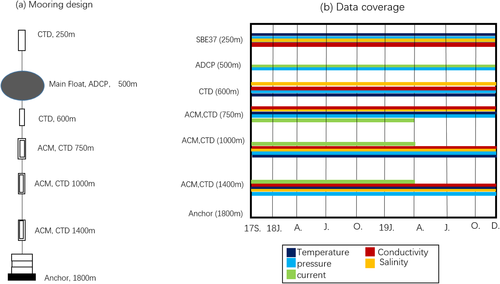印度尼西亚海区帝汶海峡海流的潜标观测结果
Moored Observations of the Timor Passage Currents in the Indonesian Seas
作者:Jing Wang, Zhengbei Zhang, Xiang Li, Zheng Wang, Yao Li, Jiajia Hao, Xia Zhao, Corry Corvianawatie, Dewi Surinati, Dongliang Yuan and Tengfei Xu
期刊:Journal of Geophysical Research: Oceans
The structure and variability of the currents in the Timor Passage are studied based on the measurements from a subsurface mooring deployed in the center of the passage from September 2017 to December 2019. The annual mean currents are found to flow westward into the Indian Ocean in the upper 1,400 m, with a maximum velocity core at ∼50 m. The mean volume transport through the Timor Passage into the Indian Ocean is estimated to be −9.9 ± 1.0 Sv (1 Sv=106m3s−1) in the upper 1,400 m with much of this transport concentrated in the upper 480 m (−8.9 Sv). This value contrasts with the estimate of −7.5 Sv above 1,890 m based on INSTANT measurements. The transport during the 2019 positive Indian Ocean Dipole event was only slightly larger than that during the 2018 normal year in the upper 480 m. The variability in the along-strait velocity in the Timor Passage is dominated by an annual cycle in the upper 150 m and a semiannual cycle in the lower layer. The annual cycle in the upper layer is mainly driven by local monsoonal forcing. Downward energy propagation is observed below 200 m, which is shown to be mainly driven by remote Kelvin waves from the Indian Ocean. The transport variability through the Timor Passage is dominated by a semiannual cycle, associated with the semiannual circulation over the equatorial Indian Ocean, with the transport in the upper and lower layers largely canceling each other in the annual cycle.

Fig. 1 The subsurface mooring configuration in the Timor Passage (a) and data coverage during the mooring period (b).
本文基于2017年9月至2019年12月布放在帝汶海峡中心的潜标测量结果,对帝汶海峡海流的结构和变率进行研究。观测发现,年平均海流向西流入印度洋上层1400米,最大核心流速约在50米处。据估算,通过帝汶海峡进入印度洋的上层1400米的海流平均流量为−9.9 ± 1.0 Sv (1 Sv = 106立方米/秒),其中大部分流量集中在上层480米(-8.9Sv)。这一数值与1890米以上海流的努沙登加拉层结及输运的国际联合观测计划(INSTANT)估算值-7.5Sv显现出明显差异。2019年发生正位相印度洋偶极子事件期间,上层480米的流量仅略大于2018年正常年份的流量。帝汶海峡沿线流速的变率主要由上层150米海流的年循环和更低层海流的半年循环主导。上层海流的年循环主要受局部季风强迫驱动。在200米以下观测到的向下能量传播主要受来自印度洋的远程开尔文波驱动。帝汶海峡的流量变率由半年循环主导,该循环与赤道印度洋的半年环流有关,在年循环中上层和下层的流量基本相互抵消。
(实习生江薇编译)








